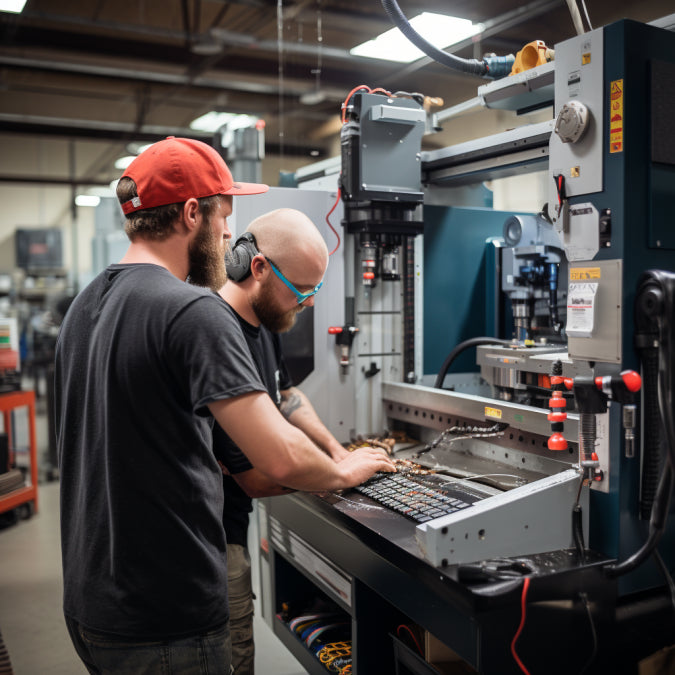Going through the process of acceptance testing for a new CNC machine can be a complex task, especially for new buyers concerned about the machine's condition and warranty.
Acceptance testing for a new CNC machine is a process of involving a series of inspections, tests, and evaluations to verify the machine's condition, performance, and compliance with manufacturer specifications. This process is important in ensuring that the machine you have invested in is defect-free, operates correctly, and meets all warranty conditions.
Few things to consider when validating your machine capabilities are preparation and physical inspection to performance testing and finalizing the acceptance test.
Preparation
- Understanding Manufacturer Specifications: Begin by thoroughly reviewing the manufacturer's specifications for your CNC machine. Familiarize yourself with its advertised capabilities, dimensions, tolerances, and unique features. This knowledge base is essential for a comparative analysis during testing.
- Gathering Essential Tools and Documents: Prepare a checklist of tools and instruments required for testing, including calipers, micrometers, and other precision measuring tools. Also, gather all relevant documentation, including the user manual, warranty information, and any test procedures recommended by the manufacturer.
- Setting Up the Test Environment: Ensure that the testing environment is suitable for conducting thorough tests. This includes adequate space around the machine, proper lighting, and ensuring that safety protocols are in place to protect the operators during testing.
Physical Inspection
- Conducting a Detailed Physical Examination: On delivery, conduct a comprehensive physical inspection of the CNC machine. Check for any visible damage, defects, or discrepancies from the specified model. Inspect all external and internal components, including the tool holder, spindle, bed, and any moving parts for signs of damage or misalignment.
- Initial Machine Setup and Installation: Follow the manufacturer's guidelines to correctly set up the CNC machine. This process includes correctly leveling the machine, establishing electrical connections, and initializing any software systems that accompany the machine.
- Verification of Accessories and Components: Cross-check the delivered components and accessories against the purchase agreement. Ensure that all parts, tools, and attachments listed are present and in good condition.
Performance and Operational Validation
- Conducting Test Runs: Perform a series of test operations to assess the functionality and performance of the CNC machine. This should include basic operations like drilling, milling, or turning, and more complex tasks if applicable to your specific machine.
- Accuracy and Tolerance Measurements: Utilize precision measuring tools to evaluate the accuracy of the machine’s outputs. Compare these measurements with the manufacturer's specified tolerances to ensure the machine is operating within acceptable limits.
- Software and Control System Assessment: Test these thoroughly for functionality, user interface, and ease of operation. Ensure that software is up-to-date and compatible with your operational requirements.
Final Steps
- Documenting Test Findings: Keep a detailed record of all testing procedures, observations, and results. This documentation is essential for any future discussions with the manufacturer or supplier, particularly if warranty service is required.
- Communication with the Supplier or Manufacturer: Report any discrepancies, issues, or concerns discovered during testing to the supplier or manufacturer immediately. It is crucial to resolve these issues prior to final acceptance of the machine.
- Warranty Considerations and Activation: Familiarize yourself with the warranty terms and conditions. Ensure that all criteria for warranty activation are met and complete any necessary procedures to activate the warranty.
Advanced Test for Specialized CNC Machines
- Testing Specialized Features and Capabilities: For CNC machines with specialized features (such as high-speed spindles, multi-axis capabilities, or advanced cooling systems), conduct tests that specifically assess these aspects. This ensures that all advertised features are functional and meet the required performance standards.
- Long-Duration and Stress Testing: Consider conducting longer duration tests or stress tests to assess how the machine performs under extended operation or heavy load. This can provide insights into the machine’s durability and reliability over time.
- Consultation with Technical Experts: If necessary, consider consulting with a technical expert or a CNC specialist to assist in advanced testing procedures. Their expertise can be invaluable in ensuring a thorough and accurate assessment of the machine.
After testing
- Analyzing Test Data and Making Informed Decisions: Analyze the data collected during testing to make informed decisions about the machine’s acceptance. If the machine meets all specifications and performs as expected, you can proceed with confidence.
- Establishing a Maintenance and Monitoring Plan: After acceptance, establish a routine maintenance and monitoring plan for the CNC machine. Regular maintenance and monitoring can help in early detection of potential issues, ensuring the longevity and optimal performance of the machine.
- Keeping Records for Future Reference: Maintain detailed records of the acceptance testing process, including any communications with the supplier or manufacturer. These records can be crucial for future reference, especially in the event of warranty claims or servicing needs.
Inshort,
- Preparation: Review specifications, prepare tools and documents, set up the testing environment.
- Physical Inspection: Comprehensive examination, machine setup, component verification.
- Performance Testing: Functional test runs, accuracy measurements, software assessment.
- Final Acceptance Steps: Documentation of findings, communication with the supplier, warranty activation.
- Advanced Testing: Assessment of specialized features, long-duration tests, expert consultation.
- Post-Testing Strategy: Data analysis, maintenance planning, record-keeping for future reference.
You now have a general understanding of how to conduct an acceptance test for your new CNC machine. By following these steps, you can assess the condition, performance, and compliance of your machine, ensuring that it meets all your requirements and is ready for production.



